From dead trees to a living creek
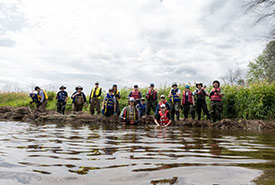
Volunteers and staff on the wing deflector. (Photo by Andrea Moreau/NCC staff)
In the Minesing Wetlands, an internationally significant wetland just west of Barrie, dead coniferous trees are bringing new life to Willow Creek. This July, I got to see it for myself when I tagged along to a Conservation Volunteers event.
Prior to joining the group for the day, I chatted with Carolyn Davies, one of the Nature Conservancy of Canada (NCC)’s Ontario conservation biology coordinators, about what the volunteers would be doing and why. “Willow Creek, this area here, was widened and straightened to allow drainage for agricultural purposes,” explained Carolyn, pointing to the creek on Google Maps’ satellite view. “And these parts deeper within the wetland haven’t been managed,” she said, zooming out and then back in on the western areas of the stream. The difference was staggering. The untouched portions of the stream were much thinner, twisting and bending freely and splitting off into different channels. They resembled intertwined tree branches, while the human-altered areas of Willow Creek were more akin to a tree’s trunk.
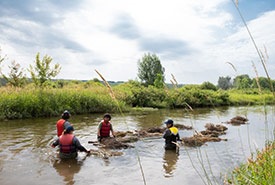
Volunteers and staff carrying trees. (Photo by Andrea Moreau/NCC staff)
Carolyn explained that without the natural curves of the stream, the water flushes through, uprooting and washing away vegetation that aquatic animals rely on for food and shelter. The high-energy water also accelerates erosion, carrying away sediment that anchors and provides nutrients to wetland plants.
To calm the flow of the water and trap some of the sediment, volunteers from NCC and the Nottawasaga Valley Conservation Authority (NVCA) install wing deflectors each year. Wing deflectors are walls of dead trees at the side of a stream, stacked and secured to one another and to the stream bed in a triangular formation, which deflects the path of the water, restoring the natural “wiggle” to the creek.
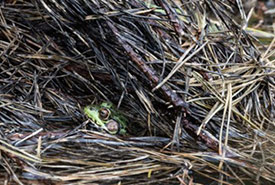
A green frog seeking shelter among the dead trees. (Photo by Andrea Moreau/NCC staff)
Installing wing deflectors is tough work, but that didn’t stop enthusiastic volunteers from showing up ready to get their feet wet. Donning chest waders and lifejackets, volunteers and staff tied the trees together, floating them down the stream where others awaited to add them to last year’s layer of trees.
Observing all the action from the creek bank, I almost felt like I was at a parade. Between the sound of laughter building as attendees moved down the creek and the percussive rhythm of anchors being hammered into the trees, the excitement was palpable.
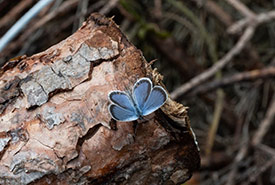
An eastern tailed-blue butterfly on one of the dead trees. (Photo by Andrea Moreau/NCC staff)
I was hesitant to get much closer to avoid getting my camera wet, but everyone looked like they were having so much fun, so I joined them in the water. Volunteers advised me on where to step to avoid flooding my chest waders or getting stuck in the mud, and I started snapping pictures from a new angle.
Despite the commotion, wildlife had already started to flock to the wing deflectors. On and around the pile of trees, we saw butterflies, frogs, birds and a very large dock spider. Fish also likely moved in once we’d gone home for the day.
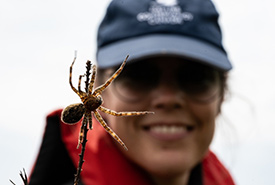
NCC’s Carolyn Davies with a dock spider. (Photo by Andrea Moreau/NCC staff)
The Minesing Wetlands are teeming with biodiversity and support over 30 at-risk species. Without restoration work, Willow Creek would be inhospitable to these animals, but the wing deflectors and over 1,300 native trees and shrubs planted by volunteers earlier this year provide much-needed habitat. Altogether, 13 volunteers, three NVCA staff and five NCC staff anchored around 250 trees into the bank in just two days. With such dedicated volunteers and visible short-term success, it’s exciting to think about what the long-term impacts of this work might be.
The 2023 Conservation Intern Program in Ontario is proudly supported by 407 ETR.
This project to improve and restore water quality in the Minesing Wetlands is being undertaken with the financial support of the Government of Canada through the federal Department of Environment and Climate Change’s EcoAction Community Funding Program. Thank you to the Ontario Wildlife Foundation who also supported this project.


